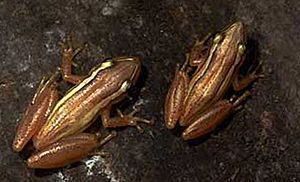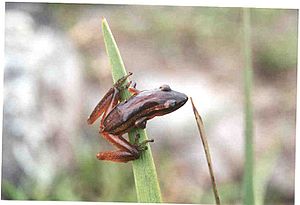Scinax squalirostris facts for kids
Quick facts for kids Scinax squalirostris |
|
|---|---|
 |
|
| Conservation status | |
| Scientific classification | |
| Synonyms | |
|
The Scinax squalirostris, also known as the striped snouted treefrog or long-snouted treefrog, is a type of frog from the Hylidae family. It lives in parts of Brazil, Uruguay, Argentina, Paraguay, and Bolivia. Scientists think there might be more than one kind of frog that looks like this one.
What it Looks Like
The Scinax squalirostris is a small frog. It measures about 24 to 29 millimeters (about 1 inch) long from its nose to its rear end. It has a slim body with thin, long legs.
Its head is longer and wider than its body, and its snout (nose area) is very long. You can easily see its eardrum, which is called a tympanum.
The frog's back is usually brownish. It has a thin, black line down the middle of its back. There are also black lines near its eyes, with white borders. Two more black stripes start from its eyes and surround a white or light-colored area. Its belly is greenish-yellow. When the male frog croaks, a large, lemon-colored sac on its throat puffs out.
Life and Home
The Scinax squalirostris lives in open areas like grasslands and fields of tall plants. You can also find it in forests. It lives in places up to 1,500 meters (about 4,900 feet) above sea level.
These frogs lay their eggs in small water bodies. This includes ponds that stay wet all the time and those that might dry up sometimes, like water holes where cows drink.
This frog is quite common and can live well even near people and their activities. However, pollution can be a problem in some specific areas. The good news is that this frog lives in several protected areas in Brazil and Argentina, which helps keep it safe.
See also
 In Spanish: Scinax squalirostris para niños
In Spanish: Scinax squalirostris para niños




